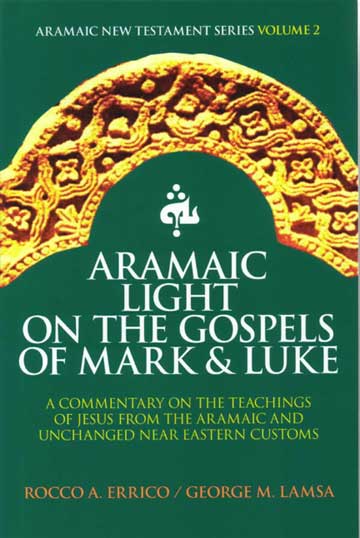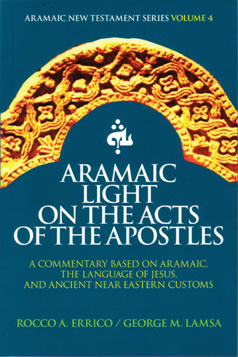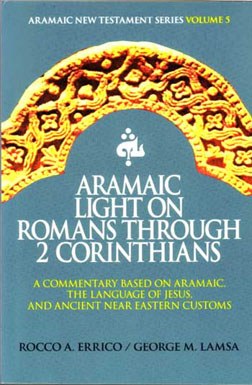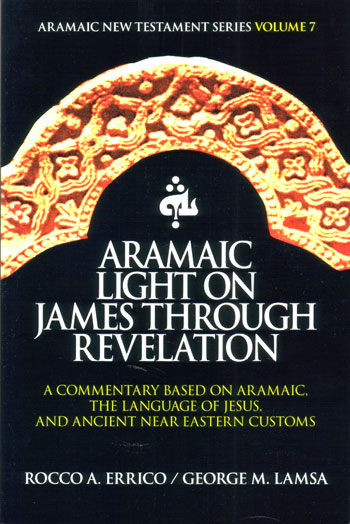|
|
 |
|
This inimitable commentary
acts as a Near Eastern guide, revealing to the Western mind a more intimate picture of the socio-religious and psychological
environment of the period. Its approach is simple, informative, and scholarly without using specialized theological terminology.
Each comment is written in narrative form, clarifying the idioms, customs, and manners of Jesus’ day. This commentary
is suitable for use by anyone who is eager to resume acquaintance with Jesus’ powerful Gospel of the Kingdom. It takes
you through the heart of the gospel, illuminating difficult and puzzling passages and offering unparalleled insight into the
character and behavior of Near Eastern Semites. This volume is more than just a revision of Dr. Lamsa’s commentaries,
Gospel Light and More Light on the Gospel. Dr. Errico has edited, expanded and annotated these previous works in the new format
that Dr. Lamsa desired. In addition, over 50% of this book contains unpublished material that the two of them had drafted
just before Dr. Lamsa died in 1975. Dr. Errico completed the comments that they had only outlined and has also added information
derived from his continual research in Aramaic word meanings and Near Eastern Semitic studies.

This book, like its predecessor Aramaic Light on the Gospel of
Matthew, carries you back almost two thousand years, providing a clear perspective of Jesus in the light of his own language,
people and times. However, this volume is unique in that it provides insight into the psychology of Jesus' healing methods.

Dr. Errico and Dr. Lamsa bring clarity and understanding to the
most popular (and most misunderstood) gospel. In the 3rd volume of thie series, you will learn the Semitic meanings behind
such terms as "the Word," "Light," "Life," "Christ," "Only Begotten." You will also come to understand what Jesus meant when
he said, "No man comes to the Father except through me" and many other sayings that appear to be sectarian and exclusive.

|
 |
|
The book of Acts comes alive under this skillful and cultural approach
of Dr. Errico and Dr. Lamsa. They bring clarification to many misunderstood verses of scripture and episodic experiences of
the apostles and growth of Jesus’ spiritual movement under apostolic guidance. Topics include: The Ascension of Jesus,
Pentecost and the Descent of the Holy Spirit, Paul’s Conversion, Healing Methods, and more.

|
 |
This first of the commentaries
on Paul's epistles presents new insights into and understanding of Paul's letters, his use of Semitic, idiomatic expressions,
admonitions and teachings that he wrote to the churches throughout the Roman Empire. It clarifies many misunderstood statements
and teachings that Paul discusses in his epistles, such as: The true righeousness of God; circumcision; Paul's use of sacrificial,
cultic terminology; Paul's intended meaning of "all have sinned and come short of the glory of God"; the manifestation of
the Sons of God; speaking in tongues of angels and men; women keeping silent in church; cup of devils; long and short hair;
how Moses brought water from a rock; the love chapter; and more.

|
 |
 |
 |
|
This second of the commentaries on Paul's epistles continues to
clarify many misunderstood statements and teachings that Paul discusses in his epistles to Jewish and Gentile followers of
Jesus' gospel, such as: The bewitched Galatians; the so-called second coming of Christ; sitting in Heavenly places with Christ;
the dispensation of the Mystery; married couples relationships; Risen with Christ, doctrines of devils; qualifications for
ministry; the mysterious Melchizedek; and more.

|
|
 |
 |
 |
|
This final volume in the Aramaic New Testament series presents
new insights into and understanding of the General Epistles, James through Jude, which were admonitions and teachings written
to the churches and scattered early Jewish believers in Jesus of Nazareth. It also brings greater clarity to the use of Semitic
idiomatic expressions and decodes the Near Eastern, Semitic symbolism employed by the book of the Revelation. Dr. Errico and
Dr. Lamsa unlock many misunderstood passages and teachings that the authors of the general epistles used when writing their
letters. They also open and shed light on the mysterious and puzzling symbols of the Revelation, showing what these symbols
meant for the people of that era, such as: The Seven Glden Lampstands, the Seven Spirits of God, the Name and Mark of the
Beast, the New Jerusalem, the return of the Tree of Life with its healing leaves, the River of Life, and much more.

|
|
|
|
|
|
 |

